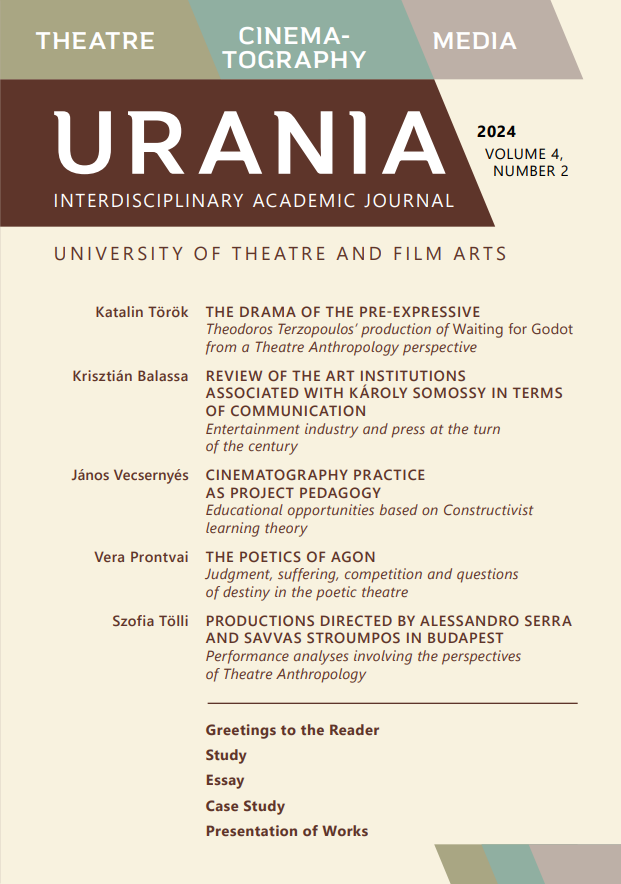Review of the art institutions associated with Károly Somossy in terms of communication
Abstract
This paper is an edited version of my thesis defended at Károli Gáspár Reformed University, Faculty of Arts Administration and Arts Management. I undertake the task of examining the communication of the entertainment institutions created by Károly Somossy, a highly influential figure of the time, from the time of the Compromise to the turn of the century after the Millennium celebrations (1867–1903). In my paper, I will explore the importance of communication, PR and marketing in the modern sense of the term, the tools were available for this, who used them and how, how much audience appeal they had, and whether it is plausible to say that the printed press was the most important communication tool of the period and, if so, how it was used by the entertainment industry. The research method I chose was to compare the popular press products of the time, the advertisements and advertising concepts of the various art institutions, after clarifying the basic concepts of communication. I have preserved the spelling of the period in the quotations. For reasons of space, I compare the data and communication of the largest and best documented institution, the Somossy Nightclub (Mulató)[1] and the Budapest Operetta Theatre, which still operates these days in the same building. This is the building which, for almost ten years, from 1894 until Somossy’s death in 1903, defined our understanding of nightlife, entertainment and amusement, and paved the way in Hungary for the uneducated child of the muses, operetta, to take off on its world-conquering journey.
[1] Since there have been several Somossy Orpheums over the decades, it is important to note that although our greatest operettas were performed in the former New Somossy Nightclub, later the Király Theatre, I am relying on the data of the Budapest Operetta Theatre at Nagymező Street 17, because this institution is still in operation and we have comparable data.
References
Áfra Nagy, János. 1930. “Az írástudatlanok Budapesten.” Statisztikai Közlemények. Volume 63. Budapest: Budapest Székesfőváros.
Bakos, Ferenc. 2002: Idegen szavak és kifejezések szótára. Budapest: Akadémiai Kiadó.
Bányász, Ibolya. 2008. A kommunikáció csatornái és jellemzői, a kommunikációs készségek fejlesztése. Budapest: Nemzeti Szakképzési és Felnőttképzési Intézet.
Bevilaqua Borsody, Béla and Béla Mazsáry. 1935. Pest-budai kávéházak: Kávé és kávésmesterség 1535–1935. II. Budapest: Budapesti Kávésok Ipartestülete.
Búza, Péter. 2020. Budapest 30. Budapest: Holnap Kiadó.
Csáth, Géza. 1909. “A pesti dal.” Nyugat 2(7): 391–392.
Forrai, Judit. 1996. “Kávéházak és kéjnők.” Budapesti Negyed 12–13: 110–120. Online access: https://epa.oszk.hu/00000/00003/00011/forrai1.htm (last visited: October 29, 2024).
Gerő, András and Berkovits György. 1996. “Mulató város.” Budapesti Negyed 3–4(1): 297–308.
Granasztói, Péter. 1997. “Tömegszórakoztatás a Városligetben: A Vurstli.” Budapesti Negyed 16–17: 163–190. Online access: https://epa.oszk.hu/00000/00003/00014/granaszt.htm (last visited: October 29, 2024).
Gyáni, Gábor. 1994. “Nyilvános tér és használói Budapesten a századfordulón.” Századok 6: 1057–1077.
Gyáni, Gábor. 1996. “A kávéházba járó polgár.” Budapesti Negyed 12–13: 57–68. Online access: https://epa.oszk.hu/00000/00003/00011/gyani.htm (last visited: October 29, 2024).
Gyárfás, Dezső. 1920. Orfeum. Budapest: Kultúra Könyvkiadó és Nyomda Rt.
Hanák, Péter. 1998a. “Bécs–Budapest–Prága városfejlődése.” Budapesti Negyed 4: 49–60. Online access: https://epa.oszk.hu/00000/00003/00017/049-060.html (last visited: 29 October, 2024).
Hanák, Péter. 1998b. “Polgárosodás és urbanizáció: Bécs és Budapest városfejlődése a 19. században.” In A Kert és a Műhely, 17–63. Budapest: Gondolat Kiadó.
Heltai, Gyöngyi. 2011. “Orfeum az operettben: A pesti zenés szórakoztatás helyszíneinek fikcionalizálása.” In Terek, tervek, történetek, 169–190. Budapest: Atelier Francia–Magyar Társadalomtudományi Központ.
Heltai, Gyöngyi. 2014. “Primadonna-paradigma: Blahától az ‘isteni Zsazsáig és Carola Cecíliától a Honthy-féle Cecíliákig’.” Metszetek 3(1): 82–116. Online access: https://epa.oszk.hu/04500/04590/00030/pdf/EPA04590_metszetek_2014_01.pdf (last visited: October 29, 2024).
Horányi, Özséb. 1977. Kommunikáció: Válogatott tanulmányok. I–II. Budapest: Közgazdasági és Jogi Könyvkiadó.
Kellér, Andor. 1968. Bal négyes páholy. Budapest: Magvető.
Koltay, András and Levente Nyakas. 1997. Magyar és európai médiajog. Budapest: Wolters Kluwer Kft. Online access: https://mersz.hu/dokumentum/wk48__520 (last visited: October 30, 2024).
Konrád, Miklós. 2008. “Orfeum és zsidó identitás Budapesten századfordulón.” Budapesti Negyed 16(2): 351–368. Online access: https://epa.oszk.hu/00000/00015/00055/pdf/02bir_voros.pdf (last visited: October 29, 2024).
Konrád, Miklós. 2013. “Brettlik, zengerájok, orfeumok.” In Ami látható és ami láthatatlan: Erzsébetváros zsidó öröksége, ed. Török Gyöngyvér. Budapest: Erzsébetváros Polgármesteri Hivatala.
Kotler, Philip. 1998. Marketing menedzsment. Hungarian translation by Péter Hámori et al. Budapest: Műszaki Könyvkiadó.
Kővágó, György. 2009. A kommunikáció elméleti és gyakorlati alapjai. Budapest: Aula Kiadó.
Krúdy, Gyula. 2008. A vörös postakocsi. Budapest: Akkord Kiadó.
M. E. 2000. “A kávéház kultusza a magyar irodalomban.” Napi Magyarország, January 22, 25–26.
Molnár Gál, Péter. 1995. “A kalábriász parti.” Budapesti Negyed 2: 73–90. Online access: https://epa.oszk.hu/00000/00003/00007/molnar.htm (last visited: October 29, 2024).
Molnár Gál, Péter. 2001. A pesti mulatók: Előszó egy színháztörténethez. Budapest: Helikon Kiadó.
Roth, Endre. 1972. “Kultúra és tömegkultúra.” Korunk 31(9): 1288–1292.
Sárközi, Mátyás. 2005. “A Király utcán végestelen-végig.” Holmi 17(9): 1071–1083.
Sármány, Ilona and Juhász, Gyula. 1996. “Amit a századforduló kávéházainak berendezéséről tudunk.” Budapesti Negyed 4(2–3): 243–260.
Sepsi, Enikő and Imre Lázár. 2013. PR és Marketingkommunikáció. Budapest: Károli Gáspár Református Egyetem. Online access: https://btk.kre.hu/ebook (via institutional access only).
Szabó, Miklós. 1978. “Politikai gondolkodás és kultúra Magyarországon a dualizmus utolsó negyedszázadában.” In Magyarország története, 1890–1918, 873–1002. Budapest: Akadémiai Kiadó.
Szalai, György. 1973. A budapesti kávéházak. I–II–III. Budapest: Hírlapkiadó Vállalat.
Tarján, Vilmos. 1940. Pesti éjszaka. Budapest: Szerzői kiadás.
T. Kiss, Tamás. 2013. “Az analfabetizmus: a dualizmus kori Magyarország kulturális/politikai problémája.” In Kultúrkapuk: tanulmányok a kultúr[politik]áról, az értékközvetítésről és a kulturális valóságról, 11–42. Szeged: Belvedere Meridionale. https://doi.org/10.14232/belvbook.2013.58503.a
Zsigmond, Zsófia. 2015. A századelő magyar kabaréja: Szórakoztatás tömegkultúra és magaskultúra határán. Manuscript. Szeged: SZTE BTK Vizuális Kultúra és Irodalomelmélet Tanszék.




